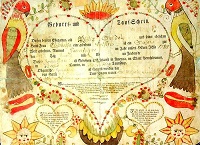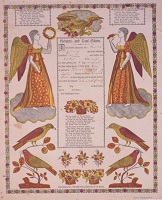 Illuminated birth and baptismal certificates are the most numerous fraktur. This is because the numerically superior “church people” (Lutheran, Reformed) among Pennsylvania Germans desired a record of these two momentous events and because the need was well satisfied by printed certificates as well as hand drawn ones. Even the Anabaptist sects, such as the Mennonites, who practiced adult baptism, produced some birth certificates, if not the baptismal variety. Taufschein fraktur have European antecedents in the Tauff-wunsch and Geburts-brief certificates for children, often with an enclosed coin (not the practice in the U.S.)
Illuminated birth and baptismal certificates are the most numerous fraktur. This is because the numerically superior “church people” (Lutheran, Reformed) among Pennsylvania Germans desired a record of these two momentous events and because the need was well satisfied by printed certificates as well as hand drawn ones. Even the Anabaptist sects, such as the Mennonites, who practiced adult baptism, produced some birth certificates, if not the baptismal variety. Taufschein fraktur have European antecedents in the Tauff-wunsch and Geburts-brief certificates for children, often with an enclosed coin (not the practice in the U.S.)

Taufschein fraktur text settled into a formula that began with the name of the child or, more commonly, “Diesen beiden Ehegatten…,” signifying the parents. As Shelley points out (p. 41), this induced the artists to lavish attention on decorative borders. Especially after 1800, the text often was printed, leaving only short entry spaces and the borders for free hand work. The original three-heart design (above) was replaced by the standing-angels variety. By mid-nineteenth century, printing houses were turning out many thousands of the common designs and these are commonly available at antique markets today.
567 thoughts on “Taufschein Fraktur”
Comments are closed.